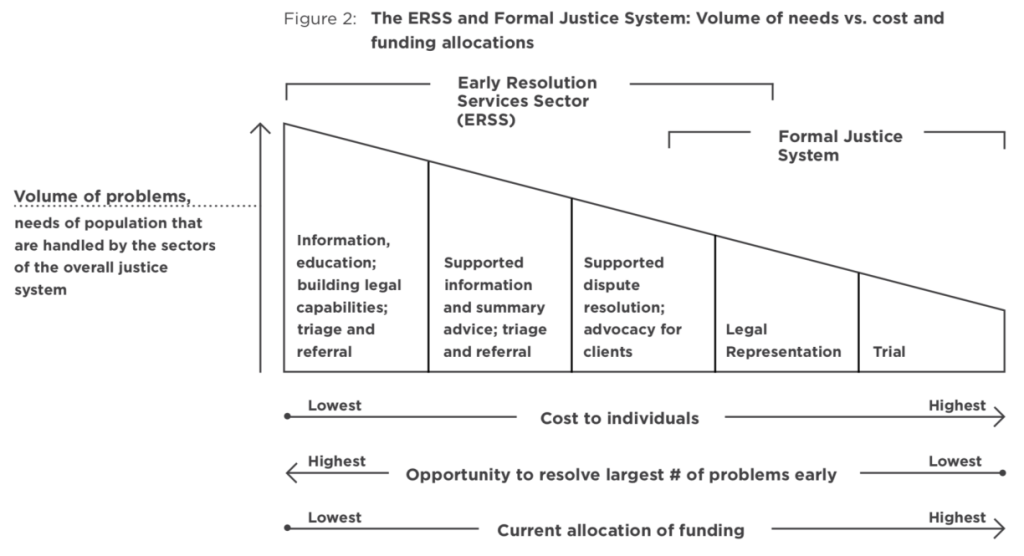Preventive law (also known as “preventative law”) is an approach to law that empowers people about their legal rights and responsibilities, while minimizing the risks of litigation.

In the cyberpunk science fiction film, The Matrix, there’s an iconic scene where the main character, Neo, meets the mysterious Morpheus character for the first time. Morpheus holds out two pills for Neo: taking the blue one lets Neo stay comfortable but blind to the truth, while taking the red one opens his eyes to reality.
As I’ve been explaining for years in CPLEA’s annual lecture for the University of Alberta Law’s Low Income Individuals and the Law course, we can think about preventive legal services the same way. We can ignore or be unaware of the early signs of legal trouble and wait until a crisis forces us to act. Or we can look deeper into reality to see law differently, and make choices that can prevent legal problems from escalating.
What is preventive law?
Preventive law is an approach to law that empowers people about their legal rights and responsibilities while minimizing the risks of litigation. It involves equipping people with legal information and insights they can use to make informed decisions for themselves or their loved ones in areas of everyday life – including their housing, health, well-being, safety and financial security.
It’s helpful to think about preventive law like preventive medicine. On a systemic level, keeping people healthy is a better allocation of resources than treating people who become sick or end up in a medical emergency. Likewise, preventing legal disputes is less costly than litigation – and not just in terms of finances. Legal issues are often lengthy or drawn out and have potential emotional and psychological costs for everyone involved.
We all know we must make lifestyle and dietary changes to reduce our risk of certain diseases. But do most of us know how to avoid or recognize a legal problem? Just as preventive medicine and public health seek to promote health and prevent disease, preventive law aims to promote “legal health”. This means helping people recognize signs of potential legal problems and helping them get appropriate supports or referrals early on — instead of offering legal help only when crisis hits.
Why prevention?
First and foremost, legal services are costly and out of reach for most people. Can you guess the average cost of a civil trial of up to 2 days in Alberta? Whenever I ask this question in our lecture, no one comes close to estimating how high this figure is. Instead, I usually get a collective gasp when I reveal the amount.
Canadian Lawyer Magazine’s 2021 Legal Fees survey states it costs just over $32,000 in Alberta. Think it’s just civil litigation that’s expensive? A family law trial of up to 2 days is just over $19,000 in Alberta. And those are 2021 dollars. Considering inflation over the last few years, you can only imagine how much higher those figures are in 2025. That’s a tough pill to swallow.
In the June 2023 CBA Podcast titled The Every Lawyer, legal coaches Jo-Anne Stark and Marcus Sixta noted the cost of a lawyer is so high now that the middle class doesn’t have the funds to take a case to court over a long period. Most people earning $60,000 to 80,000 (I’m paraphrasing here about what is a “middle class” income) don’t have $30,000 available for a trial.
Community legal clinics, student legal clinics and Legal Aid are all crucial in filling the legal services gap for low-income individuals. However, there is a significant population of middle-class folks with limited or no access to legal services.
Greatest opportunity lies in prevention
Justice innovation researchers here in Canada and elsewhere recognize that the greatest opportunity to resolve the highest number of legal problems is early in the resolution spectrum. This is done through low-cost options like information, education, building legal capabilities, triaging issues and referring folks for more help. As you move along the resolution spectrum towards legal representation and trial, the cost to the individual increases and the opportunity to resolve the largest number of problems early decreases. Despite the greatest opportunity in early resolution services, our legal services model allocates the most funding to the formal justice system.

People with ample financial resources can access general legal services to help them plan ahead or deal with critical junctures in different areas of their lives, such as getting married or divorced, welcoming a child, leasing or purchasing a home, paying taxes, or estate planning.
Yet, the typical household cannot afford to call a lawyer to deal with these same life milestones. They can only gain access to legal information and education through charitable or publicly funded providers when a crisis hits, be it catastrophic illness, job loss, housing loss, domestic violence, sexual assault or arrest on criminal charges.
The role of public legal information and education (PLEI)
We know that people gain understanding of “law” through many channels in our everyday lives – the media, schools, community agencies, government, information centres and libraries, friends and families, justice navigators, or online. While we recognize that people may not turn to PLEI until they are actually in a crisis or dealing with a legal issue, we at CPLEA strive to create widely accessible, multichannel PLEI with a preventive approach in mind. This means at the very least:
- providing people with awareness, knowledge and understanding of rights and legal issues
- building public confidence and the skills people need to deal with disputes and gain access to justice
- helping people recognize when they may need support, what sort of advice is available, and how to get it
- helping people better understand everyday life issues, so they can make better decisions and anticipate and avoid problems
Through such an approach, we hope to one day have people understand basic “legal health” in the same way that most people understand basic “medical health” knowledge.
Looking for more information?
Looking for articles like this one to be delivered right to your inbox? SUBSCRIBE NOW!
DISCLAIMER The information in this article was correct at time of publishing. The law may have changed since then. The views expressed in this article are those of the author and do not necessarily reflect the views of LawNow or the Centre for Public Legal Education Alberta.

